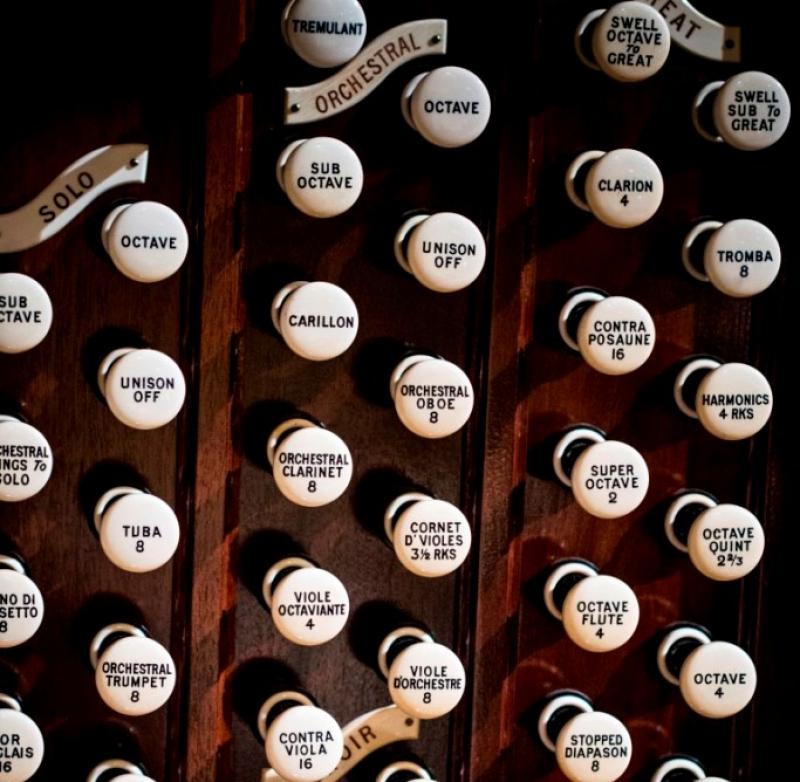Escaich, RSNO, Märkl, Usher Hall, Edinburgh | reviews, news & interviews
Escaich, RSNO, Märkl, Usher Hall, Edinburgh
Escaich, RSNO, Märkl, Usher Hall, Edinburgh
Organic grandeur stops short of engagement

It does not seem like 12 years since the organ in the Usher Hall was restored to full working order. That may be because, in the minds of many Edinburghers, the recent years of untroubled service are still eclipsed by the many decades in which Norman and Beard’s monumental instrument sat silent, reproaching the City Fathers for their parsimony.
Which made this concert by the Royal Scottish National Orchestra rather special, as it included not only the quirkily discordant organ concerto by Poulenc but also the rather more massive sonorities of the Third, "Organ" Symphony by Saint-Saëns. With the French organist Thierry Escaich (pictured below by Guy Vivien) at the console, the evening promised to be a treat for those lured by power and the seductive rumble of a 32-foot pedal stop.
 In the event, the overall effect was rather less overwhelming than might have been expected. The concert in fact opened with Les préludes, a purely orchestral piece by Liszt. Conductor Jun Märkl began with great poise, pulling together Liszt’s rather disparate material with precision and skill. But for all its colour and bombast, this is a somewhat soulless piece that needs a commitment beyond just the notes to make it sing.
In the event, the overall effect was rather less overwhelming than might have been expected. The concert in fact opened with Les préludes, a purely orchestral piece by Liszt. Conductor Jun Märkl began with great poise, pulling together Liszt’s rather disparate material with precision and skill. But for all its colour and bombast, this is a somewhat soulless piece that needs a commitment beyond just the notes to make it sing.
The Poulenc followed, the orchestra pared down to timpanist and strings. The concerto’s kaleidoscopic organ colours would test any instrument: one moment we have a brassy Bach toccata, the next a wheezy fairground organ, and then a quasi-religious chorale. Escaich did not disappoint us, producing a dazzling array of different sounds and textures, the huge ranks of original 1914 drawstops gliding in and out in endlessly changing combinations, thanks to a modern sequencing system.
There were moments of effortless grandeur, evanescent beauty, and sheer Poulenc mayhem. But there was something lacking. Was it simply volume? Joie de vivre? Maybe the Usher Hall is simply too civilised a space, with a well-behaved acoustic, for a piece whose gothic fantasies would work best in a huge cathedral dimly lit by candles.
This is one of the greatest and most popular works for organ and orchestra
After the interval, we were on solid romantic ground in the Saint-Saëns Third Symphony. For all that this is one of the greatest and most popular works for organ and orchestra, the organ’s contribution is somewhat predictable – a radiantly deep backcloth in the Adagio and great tub-thumping chords to propel the final movement to its conclusion. That’s not to say that there is anything wrong with predictable; in the case of the Adagio, Märkl and Escaich produced the loveliest of sounds, teasingly sensual harmonies reminding us that Saint-Saëns was also the composer of the world’s sexiest aria "Mon coeur s’ouvre à ta voix".
The purely orchestral movements had some zest for life, with burbling woodwinds and an unusual edgy sound from the lower strings, but the final peroration, for all the gathering momentum and swelling volume, seemed less successful. The late Carlo Curley, who championed this noble old instrument at a time when it could barely play for five minutes without a breakdown, once played a great chord and exclaimed “Feel how it moves the air!” The air certainly moved in the Saint-Saëns but it was strangely unengaging.
rating
Explore topics
Share this article
The future of Arts Journalism
You can stop theartsdesk.com closing!
We urgently need financing to survive. Our fundraising drive has thus far raised £49,000 but we need to reach £100,000 or we will be forced to close. Please contribute here: https://gofund.me/c3f6033d
And if you can forward this information to anyone who might assist, we’d be grateful.

Subscribe to theartsdesk.com
Thank you for continuing to read our work on theartsdesk.com. For unlimited access to every article in its entirety, including our archive of more than 15,000 pieces, we're asking for £5 per month or £40 per year. We feel it's a very good deal, and hope you do too.
To take a subscription now simply click here.
And if you're looking for that extra gift for a friend or family member, why not treat them to a theartsdesk.com gift subscription?
more Classical music
 Echo Vocal Ensemble, Latto, Union Chapel review - eclectic choral programme garlanded with dance
Beautiful singing at the heart of an imaginative and stylistically varied concert
Echo Vocal Ensemble, Latto, Union Chapel review - eclectic choral programme garlanded with dance
Beautiful singing at the heart of an imaginative and stylistically varied concert
 Scott, Irish Baroque Orchestra, Whelan, RIAM, Dublin review - towards a Mozart masterpiece
Characteristic joy and enlightenment from this team, but a valveless horn brings problems
Scott, Irish Baroque Orchestra, Whelan, RIAM, Dublin review - towards a Mozart masterpiece
Characteristic joy and enlightenment from this team, but a valveless horn brings problems
 Classical CDs: Voice flutes, flugelhorns and froth
Baroque sonatas, English orchestral music and an emotionally-charged vocal recital
Classical CDs: Voice flutes, flugelhorns and froth
Baroque sonatas, English orchestral music and an emotionally-charged vocal recital
 Kanneh-Mason, Britten Sinfonia, Shave, Milton Court - a grin and a big beaming smile
A pair of striking contemporary pieces alongside two old favourites
Kanneh-Mason, Britten Sinfonia, Shave, Milton Court - a grin and a big beaming smile
A pair of striking contemporary pieces alongside two old favourites
 theartsdesk at the New Ross Piano Festival - Finghin Collins’ musical rainbow
From revelatory Bach played with astounding maturity by a 22 year old to four-hand jazz
theartsdesk at the New Ross Piano Festival - Finghin Collins’ musical rainbow
From revelatory Bach played with astounding maturity by a 22 year old to four-hand jazz
 First Person: Manchester Camerata's Head of Artistic Planning Clara Marshall Cawley on questioning the status quo
Five days of free events with all sorts of audiences around Manchester starts tomorrow
First Person: Manchester Camerata's Head of Artistic Planning Clara Marshall Cawley on questioning the status quo
Five days of free events with all sorts of audiences around Manchester starts tomorrow
 Goldscheider, Brother Tree Sound, Kings Place review - music of hope from a young composer
Unusual combination of horn, strings and electronics makes for some intriguing listening
Goldscheider, Brother Tree Sound, Kings Place review - music of hope from a young composer
Unusual combination of horn, strings and electronics makes for some intriguing listening
 theartsdesk Q&A: composer Donghoon Shin on his new concerto for pianist Seong-Jin Cho
Classical music makes its debut at London's K-Music Festival
theartsdesk Q&A: composer Donghoon Shin on his new concerto for pianist Seong-Jin Cho
Classical music makes its debut at London's K-Music Festival
 Helleur-Simcock, Hallé, Wong, Bridgewater Hall, Manchester review - moving lyricism in Elgar’s concerto
Season opener brings lyrical beauty, crisp confidence and a proper Romantic wallow
Helleur-Simcock, Hallé, Wong, Bridgewater Hall, Manchester review - moving lyricism in Elgar’s concerto
Season opener brings lyrical beauty, crisp confidence and a proper Romantic wallow
 Kohout, Spence, Braun, Manchester Camerata, Huth, RNCM, Manchester review - joy, insight, imagination and unanimity
Celebration of the past with stars of the future at the Royal Northern College
Kohout, Spence, Braun, Manchester Camerata, Huth, RNCM, Manchester review - joy, insight, imagination and unanimity
Celebration of the past with stars of the future at the Royal Northern College

Add comment